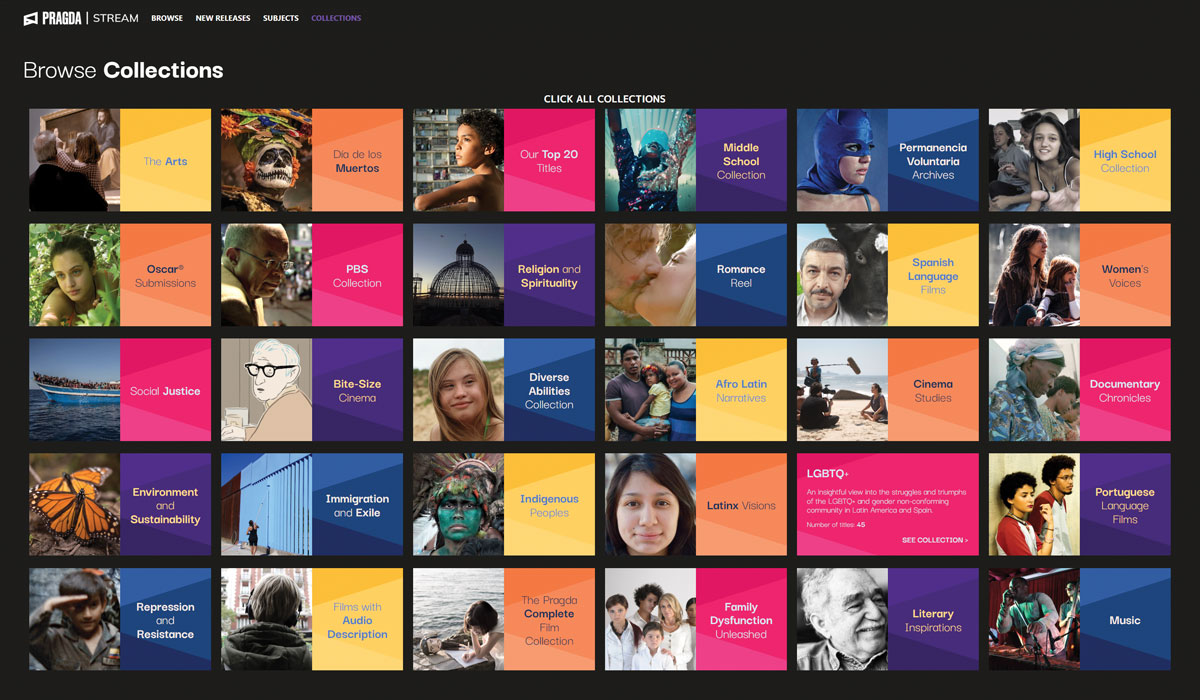SLJ Reviews Pragda Stream Database
Pragda Stream is an educational streaming platform with a fresh offering of Latin American films, documentaries, and series to a U.S. audience. See what our reviewer had to say about its curated list for middle and high schoolers.
Grade Level Gr 6 Up
Cost Quote upon request
Content Pragda Stream is an educational streaming platform with a fresh offering of Latin American films, documentaries, and series to a U.S. audience. The home page, a collage of film stills; black backgrounds; and white-colored text, promotes Pragda’s aim—“Raising the Voice of Latin Cinema.” Its focus is on Latinx, Latin American, and Spanish films. There is a menu located at the top left of the home page with clickable tabs: Browse, New Releases, Subjects, and Collections. While the repository includes films for all ages, a selection has been curated for middle and high school viewers.
Selecting Browse gives the option to view the array of 516 films included in Pragda Stream with an image of their poster and film title. In addition, this section provides the opportunity to use an advanced filter to narrow titles by subject, country, genre, length, language, grade level, and OCLC number. Users can click more than one option within each filter/category to reach specific options aligned with their interests. Clicking the New Releases tab brings users to a list with film posters/titles; hovering over each image provides the film title, genre, country, and a brief synopsis. Selecting the Subjects tab produces a list, in alphabetical order, of different topics, from “Activism” to “Youth.” The list of subjects is not exhaustive, and it leans more toward high school and university courses. The topics include “Oscar Contenders,” but no other awards from Latin America, Spain, or the world that celebrate and acknowledge other “Latin Cinema.” The last tab, Collections, generates a curated list of films that fall under broader themes, ranging from “The Arts” to “Student Life.” When hovering over the collection icon, users will observe the name of the collection, a brief description, and how many titles are featured. These Pragda-created collections include selections that highlight historically marginalized identities and communities, such as “Diverse Abilities,” “Afro Latin Narratives,” “Indigenous Peoples,” and “LGBTQ+.”
Scrolling down the home page, users will see yellow, orange, and magenta tabs: the “Librarian” tab leads to resources to “diversify your catalog.” The “Professor” tab/platform, among other goals, hopes to “foster cultural breadth in interdisciplinary programs.” Meanwhile, “Patron” is directed at students and how it can “enrich [their] research and learn about the global Latin world in an entertaining way.”
Clicking on an individual film or series title will take users to a page highlighting the featured title through visuals and texts. The film profiles include the title (sometimes English/Spanish), director, genres, year, length in minutes, countries/nationality, brief synopsis, a trailer, subject tags, languages, if it is color or black and white, grade level, subtitle and audio description use, cataloging information (MARC records or subjects), festival participation, and clips. It also provides recommendations of related films and collections. Occasionally, some of the information and subjects presented can be confusing to users. For example, some films include non–Latin American countries under “Countries/Nationality” without explaining if it is a multi-country production, or if the director/production company is from that country or if the subjects are from a Latin American country. In other examples, there isn’t a clear explanation of why these choices were made. The exclusion of performers' names can be a disservice to students and educators wanting to find films by specific actors/actresses or racial/ethnic backgrounds.
Students and Teachers This streaming platform states that their user-friendly tools and interface can be implemented with learning management systems (LMS) used in schools, universities, and classrooms. Upper middle school and high school students and educators can use these films and resources for transmedia approaches and support to research topics and curricula. These titles can enhance and support Ethnic, Gender, and Latinx Studies courses and students’ various learning styles and knowledge. History, Languages, and Science courses can also benefit from this resource by providing alternative narratives from various perspectives.
Verdict The navigability of Pragda Stream is swift and friendly for users with experience with websites and streaming platforms. Its curated selections are distinctive from other stream services and educational resources available for libraries and schools. Although some of their picks are available in other library services, such as Kanopy, Pragda provides the opportunity for schools and libraries to incorporate counternarratives, various points of view, and experiences, as well as a variety of languages into the curriculum that are not often reflected in classrooms. Depending on the cost and the library and school budget, Pragda Stream is a recommended resource to enhance virtual and in-person learning experiences for students.
Sujei Lugo Vázquez is a children’s librarian at Boston Public Library.
RELATED
The job outlook in 2030: Librarians will be in demand
The job outlook in 2030: Librarians will be in demand
ALREADY A SUBSCRIBER? LOG IN
We are currently offering this content for free. Sign up now to activate your personal profile, where you can save articles for future viewing







Add Comment :-
Be the first reader to comment.
Comment Policy:
Comment should not be empty !!!